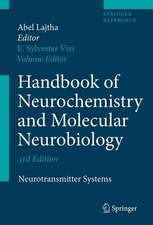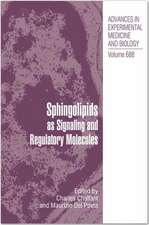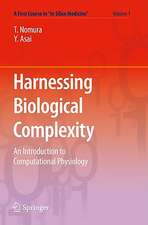Immediate Early Genes in Sensory Processing, Cognitive Performance and Neurological Disorders
Editat de Raphael Pinaud, Liisa A. Tremereen Limba Engleză Paperback – 17 sep 2014
| Toate formatele și edițiile | Preț | Express |
|---|---|---|
| Paperback (1) | 944.82 lei 6-8 săpt. | |
| Springer Us – 17 sep 2014 | 944.82 lei 6-8 săpt. | |
| Hardback (1) | 951.77 lei 6-8 săpt. | |
| Springer Us – 15 aug 2006 | 951.77 lei 6-8 săpt. |
Preț: 944.82 lei
Preț vechi: 1152.22 lei
-18% Nou
Puncte Express: 1417
Preț estimativ în valută:
180.80€ • 193.33$ • 150.74£
180.80€ • 193.33$ • 150.74£
Carte tipărită la comandă
Livrare economică 17 aprilie-01 mai
Preluare comenzi: 021 569.72.76
Specificații
ISBN-13: 9781489987433
ISBN-10: 1489987436
Pagini: 304
Ilustrații: X, 293 p.
Dimensiuni: 155 x 235 x 16 mm
Greutate: 0.43 kg
Ediția:2006
Editura: Springer Us
Colecția Springer
Locul publicării:New York, NY, United States
ISBN-10: 1489987436
Pagini: 304
Ilustrații: X, 293 p.
Dimensiuni: 155 x 235 x 16 mm
Greutate: 0.43 kg
Ediția:2006
Editura: Springer Us
Colecția Springer
Locul publicării:New York, NY, United States
Public țintă
ResearchDescriere
Immediate early genes (IEGs) are a class of genes that are rapidly expressed without new protein synthesis and, in most cases, in direct response to synaptic input. The most widely studied IEGs in neurobiology encode transcription factors, with two popular examples being c-fos and NGFI-A (a.k.a., zif268 , egr-1, krox-24 and zenk). The activity-dependent expression of most inducible transcription factors has enabled neuroscientists to use their expression as mapping tools for neuronal activation, thereby enhancing our understanding of the anatomical and functional organization of the central nervous system (CNS). IEGs, however, are known to encode not only transcription factors, but a much wider variety of proteins including signaling molecules, growth factors and cytoskeletal proteins. IEGs are therefore both directly and indirectly implicated in the dynamic functional and anatomical restructuring of the CNS that permits the rapid integration of new sensory experience with pre-existing or on-going neural function. Finally, recent evidence suggests that IEGs may also be implicated in the initiation or amplification of aberrant signaling in connection with neuropathological disorders.
This book reviews and details experiments and theories that challenge the reader to expand their view on how IEG research is currently being used to advance our understanding of static and active brain circuits, enabling the processing, acquisition and storage of new information in healthy systems. In addition, we explore roles of IEGs in clinical neuropathology, with potential utility in molecular modeling, to highlight, on a go-forward basis, candidate mechanisms for novel targets in clinical intervention.
This book reviews and details experiments and theories that challenge the reader to expand their view on how IEG research is currently being used to advance our understanding of static and active brain circuits, enabling the processing, acquisition and storage of new information in healthy systems. In addition, we explore roles of IEGs in clinical neuropathology, with potential utility in molecular modeling, to highlight, on a go-forward basis, candidate mechanisms for novel targets in clinical intervention.
Cuprins
Preface.- Contributors.- The Use of Immediate Early Genes as Mapping Tools for Neuronal Activation: Concepts and Methods.- Part I Immediate Early Gene Expression as Part of Sensory Processing: Regulation of Immediate Early Genes in the Visual Cortex.- Immediate Early Gene Regulation in the Auditory System.- Immediate Early Genes and Sensory Maps of Olfactory and Gustatory Function.- Immediate Early Gene Expression in the Primary Somatosensory Cortex: Focus on the Barrel Cortex.- Immediate Early Genes Induced in Models of Acute and Chronic Pain.- Part II Immediate Early Gene Expression in Complex Systems and Higher Order Cognitive Function: Mapping Sleep-Wake Control With the Transcription Factor c-Fos.- c-Fos and Zif268 in Learning and Memory – Studies on Expression and Function.- Immediate Early Genes and the Mapping of Environmental Representations in Hippocampal Neural Networks.- Neural Dysfunction and Cognitive Impairment Resulting From Inactivation of the Egr-Family Transcription Factor Zif268.- Part III Immediate Early Genes in Neurological Disorder: Clinical Implications: The Contribution of Immediate Early Genes to the Understanding of Brain Processing of Stressors.- Transcriptional Control of Nerve Cell Death, Survival and Repair.- Immediate Early Genes, Inducible Transcription Factors and Stress Kinases in Alzheimer's Disease.- Parkinson's Disease, the Dopamine Pathway and Immediate Early Genes.
Textul de pe ultima copertă
Immediate early genes (IEGs) are a class of genes that are rapidly expressed without new protein synthesis and, in most cases, in direct response to synaptic input. The most widely studied IEGs in neurobiology encode transcription factors, with two popular examples being c-fos and NGFI-A (a.k.a., zif268, egr-1, krox-24 and zenk). The activity-dependent expression of most inducible transcription factors has enabled neuroscientists to use their expression as mapping tools for neuronal activation, thereby enhancing our understanding of the anatomical and functional organization of the central nervous system (CNS). IEGs, however, are known to encode not only transcription factors, but a much wider variety of proteins including signaling molecules, growth factors and cytoskeletal proteins. IEGs are therefore both directly and indirectly implicated in the dynamic functional and anatomical restructuring of the CNS that permits the rapid integration of new sensory experience with pre-existing or on-going neural function. Finally, recent evidence suggests that IEGs may also be implicated in the initiation or amplification of aberrant signaling in connection with neuropathological disorders.
This book reviews and details experiments and theories that challenge the reader to expand their view on how IEG research is currently being used to advance our understanding of static and active brain circuits, enabling the processing, acquisition and storage of new information in healthy systems. In addition, we explore roles of IEGs in clinical neuropathology, with potential utility in molecular modeling, to highlight, on a go-forward basis, candidate mechanisms for novel targets in clinical intervention.
This book reviews and details experiments and theories that challenge the reader to expand their view on how IEG research is currently being used to advance our understanding of static and active brain circuits, enabling the processing, acquisition and storage of new information in healthy systems. In addition, we explore roles of IEGs in clinical neuropathology, with potential utility in molecular modeling, to highlight, on a go-forward basis, candidate mechanisms for novel targets in clinical intervention.
Caracteristici
Provides a compilation of the most up-to-date literature on the topic of immediate early genes (IEGs), by the leading authors of the field of molecular neuroscience
Includes supplementary material: sn.pub/extras
Includes supplementary material: sn.pub/extras














